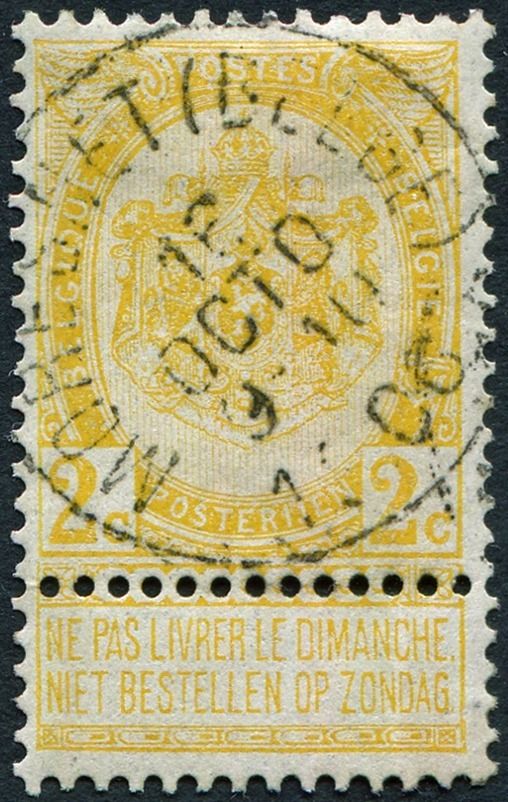

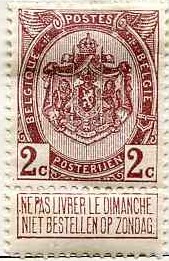
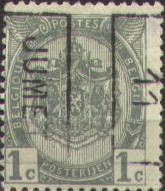
Return To Catalogue - Belgium 1849-1868 - Belgium 1869-1892 - Belgium 1915 onwards
Currency: 100 Centimes = 1 Franc
Note: on my website many of the
pictures can not be seen! They are of course present in the cd's;
contact me if you want to purchase them: evert@klaseboer.com.
Gereral remarks about stamps with tab; when the tab is no longer attached to the stamp, the stamp is less valuable.
For stamps of Belgium from 1893 to 1920 click here.
1 c grey 2 c yellow 2 c brown (1894) 5 c green
For the specialist: the 1 c , 2 c brown and 5 c green were also issued without ornaments where the stamp and the tab joins in 1907. These stamps are perforated 14.
Value of the stamps |
|||
vc = very common c = common * = not so common ** = uncommon |
*** = very uncommon R = rare RR = very rare RRR = extremely rare |
||
| Value | Unused | Used | Remarks |
| 1 c | vc | vc | with ornaments |
| 1 c | * | vc | without ornaments |
| 2 c yellow | c | * | with ornaments |
| 2 c brown | c | vc | with ornaments |
| 2 c brown | * | * | without ornaments |
| 5 c | c | vc | with ornaments |
| 5 c | ** | vc | without ornaments |
I have seen postal stationery in this design: 5 c green (with tab and ornaments) and 5 c green (with tab but no ornaments).

(Precancel)
More info on precancels can be found in the book: 'Catalogue des Preos Belge 1894-1937' by Jean Lepingle (in French)
Some very rare non-issued stamps exist with overprint 'CHINE' and value in 'CENTS'. I have seen a Hialeah forgery of a '2 CENTS' on 5 c green stamp, made with a computer scanner and printer. The printing is very bad and the perforation is wrong. They are often offered on E-bay.
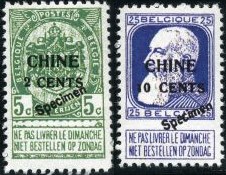
Some forged 'CHINE Specimen' Hialeah overprints. The stamps are
also forged (made by a computer scanner and printer), reduced
sizes.
5 c green on red 10 c red on blue 25 c blue on red
For the specialist: these stamps are perforated 14.
Value of the stamps |
|||
vc = very common c = common * = not so common ** = uncommon |
*** = very uncommon R = rare RR = very rare RRR = extremely rare |
||
| Value | Unused | Used | Remarks |
| 5 c | c | c | |
| 10 c | c | c | |
| 25 c | c | * | |
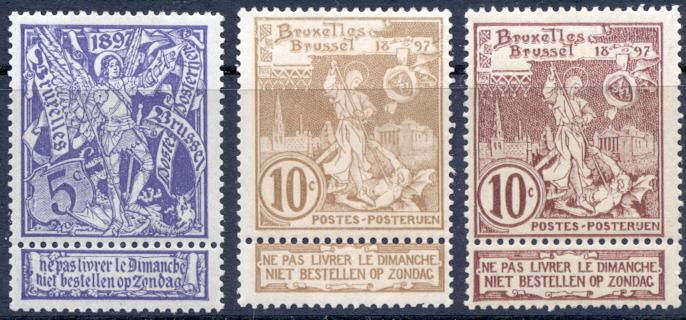
5 c lilac 10 c brown 10 c lilac
For the specialist, these stamps are perforated 14.
Value of the stamps |
|||
vc = very common c = common * = not so common ** = uncommon |
*** = very uncommon R = rare RR = very rare RRR = extremely rare |
||
| Value | Unused | Used | Remarks |
| 5 c | c | c | |
| 10 c brown | * | * | |
| 10 c lilac | c | c | |
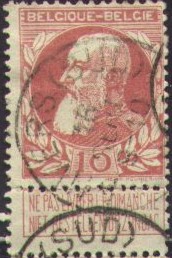
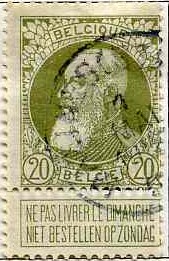
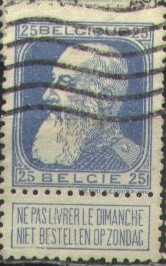
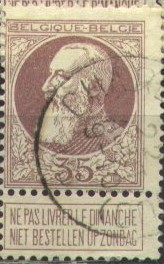
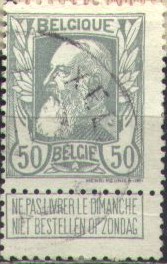
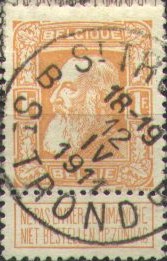
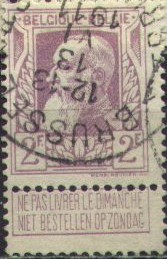
10 c red 20 c green 25 c blue 35 c brown 50 c grey 1 F yellow 2 F lilac
These stamps are perforated 14.
Value of the stamps |
|||
vc = very common c = common * = not so common ** = uncommon |
*** = very uncommon R = rare RR = very rare RRR = extremely rare |
||
| Value | Unused | Used | Remarks |
| 10 c | * | vc | |
| 20 c | ** | vc | |
| 25 c | ** | vc | |
| 35 c | ** | c | |
| 50 c | *** | * | |
| 1 F | *** | ** | |
| 2 F | *** | ** | |
I have seen postal stationery in this design (with tab): 10 c red and 25 c blue.
Some very rare non-issued stamps exist with overprint 'CHINE' and value in 'CENTS'. I have seen a Hialeah forgery of a '4 CENTS' on 10 c red stamp, made with a computer scanner and printer. The printing is very bad and the perforation is wrong. They are often offered on E-bay.
I've been told that the next stamps are forgeries of the 20 c, 35 c and 2 F values on authentic paper taken from the border of the sheet. They were made in the United States.

Some forged 'CHINE Specimen' Hialeah overprints. The stamps are
also forged (made by a computer scanner and printer), reduced
sizes.
Another forgery of the 2 F exists, in which the epaulette of the King ends at the corner of the square with '2F'; in the genuine stamps it ends much further to the right.
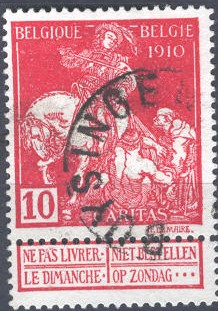
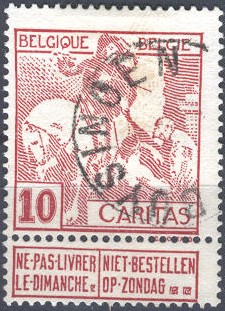
(The two types of the 10 c, type I left , type II right)
1 c grey 1 c green 2 c brown 5 c blue 10 c red
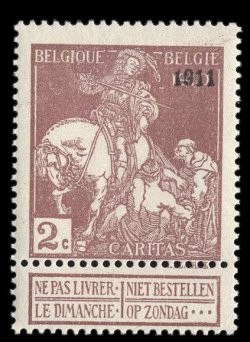
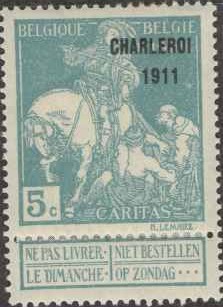
('1911' and 'CHARLEROI 1911' overprint)
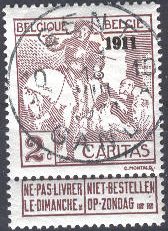
(Overprinted '1911', reduced size)
These stamps exist in 2 types, and exist overprinted '1911' and 'CHARLEROI 1911'.
vc = very common c = common * = not so common ** = uncommon |
*** = very uncommon R = rare RR = very rare RRR = extremely rare |
|||||
Type I |
Type II |
|||||
| Value | Unused | Used | Remarks | Unused | Used | Remarks |
| 1 c | * | * | * | * | ||
| 2 c | * | * | * | * | ||
| 5 c | * | * | * | * | ||
| 10 c | * | * | * | * | ||
| Overprinted '1911' | ||||||
| 1 c | *** | *** | *** | *** | ||
| 2 c | *** | *** | *** | *** | ||
| 5 c | * | * | * | * | ||
| 10 c | * | * | * | * | ||
Overprinted 'CHARLEROI 1911' |
||||||
| 1 c | * | * | * | * | ||
| 2 c | * | * | * | * | ||
| 5 c | * | * | * | * | ||
| 10 c | * | * | * | * | ||
In 1926 a similar design was issued with inscription 'INONDATIONS WATERSNOOD' at the bottom (two types): 1 F + 1 F blue.
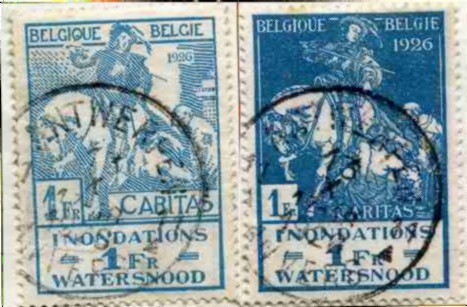
1 c orange (number) 2 c brown (lion) 5 c green (lion)
Value of the stamps |
|||
vc = very common c = common * = not so common ** = uncommon |
*** = very uncommon R = rare RR = very rare RRR = extremely rare |
||
| Value | Unused | Used | Remarks |
| 1 c | vc | vc | |
| 2 c | vc | vc | |
| 5 c | vc | vc | |
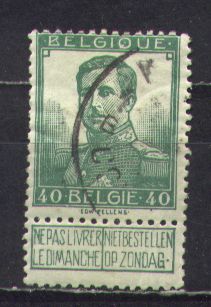
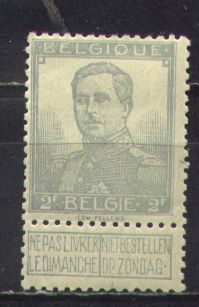
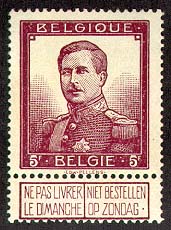
(Reduced size)
10 c red 20 c olive 25 c blue 35 c brown 40 c green 50 c grey 1 F orange 2 F violet 5 F brown (larger size)
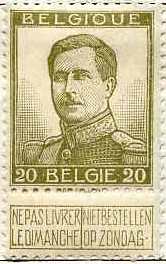
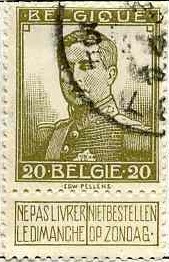
(Two types: one button left and two buttons right)
For the specialist: two types exist of these stamps. In type I there are two buttons on the uniform of the king, all stamps except the 25 c were issued in type I. In type II there is only one button on the uniform and the head of the king is larger, the values 10 c, 20 c, 25 c and 40 c were issued in type II. The values 10 c, 20 c and 25 c of type II exist in a subtype without the name of the engraver.
Value of the stamps |
|||
vc = very common c = common * = not so common ** = uncommon |
*** = very uncommon R = rare RR = very rare RRR = extremely rare |
||
| Value | Unused | Used | Remarks |
| 10 c | * | c | two buttons |
| 10 c | vc | vc | one button |
| 20 c | ** | * | two buttons |
| 20 c | * | * | one button |
| 25 c | c | c | |
| 35 c | * | * | |
| 40 c | *** | *** | two buttons |
| 40 c | * | * | one button |
| 50 c | * | * | |
| 1 F | ** | * | |
| 2 F | *** | *** | |
| 5 F | *** | *** | |
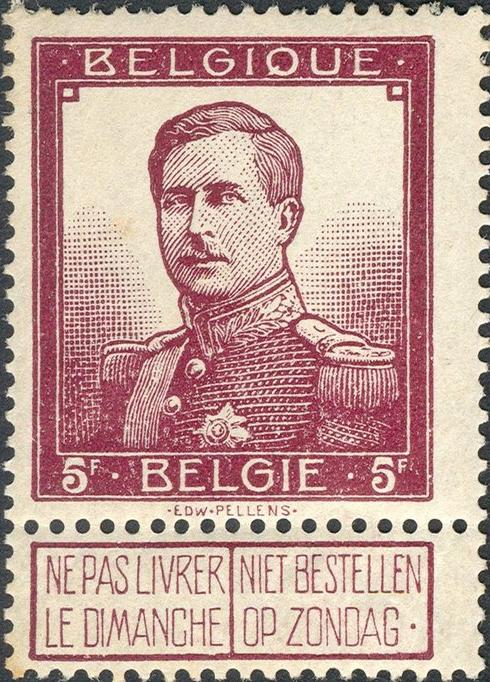
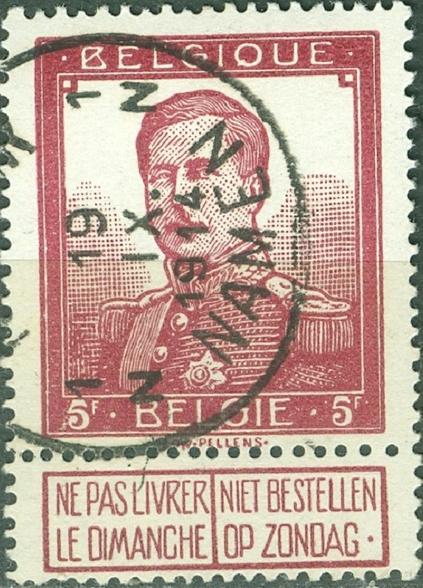
On the left, presumably genuine stamp. On the right: Deceptive
forgery. Note that the 'S' of 'PELLENS' is larger, the background
on the right is less gradually shaded, the second line on the
'epaulette' on the left (from our point of view) is not correct
(all lines should be parallel in the genuine stamp).
I've seen deceptive forgeries of the 5 F with cancel 'SCHAERBEEK 19-20 6 V 1913' or 'NAMUR 19 IX. 1914 NAMEN 1N 1N' (see image above).
If I'm well informed the lower values have also been forged (30 c and 1 F). These types with two buttons were forged, they are quite dangerous.
5 c green 10 c red 20 c lilac
Value of the stamps |
|||
vc = very common c = common * = not so common ** = uncommon |
*** = very uncommon R = rare RR = very rare RRR = extremely rare |
||
| Value | Unused | Used | Remarks |
| 5 c | *** | *** | |
| 10 c | *** | *** | |
| 20 c | *** | *** | |
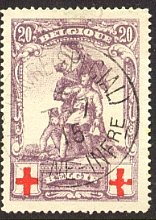
(forgery with cancel, reduced size)
These stamps are quite rare. However, enormous quantities of
forgeries exist. The forgeries can easily be recognized by the
'Q' of 'BELGIQUE', this should be a real 'Q', but in the
forgeries it resembles more an 'O'. Perforated and imperforate
forgeries with or without forged cancels exist. The above stamps
are forgeries.
According to www.bondskeuringsdienst.nl/BKD.pps,
these forgeries were made by the Belgian forger Verschueren from
Antwerp (the printer who printed the original stamps). The 1915
red cross issue (King Albert, small size) was also forged by him.
These forgeries also exist on letter (a letter adressed to
Monsieur Levionnois 15, Rue de Charleroi Charleroi can be found
on the above mentioned website) with a full set of all six
forgeries. I've also seen a forged letter with all three above
stamps and the 1915 King Albert small sized stamps (all three) on
a letter to 'Monsieur Lauwers 33, Avenue Louise Bruxelles' with
the same cancel as shown above 'ANTWERPEN ANVERS 11-12 7 1914'.
See also http://postzegelsdemerode.be/NL/vervalsingenf.html
for more information.